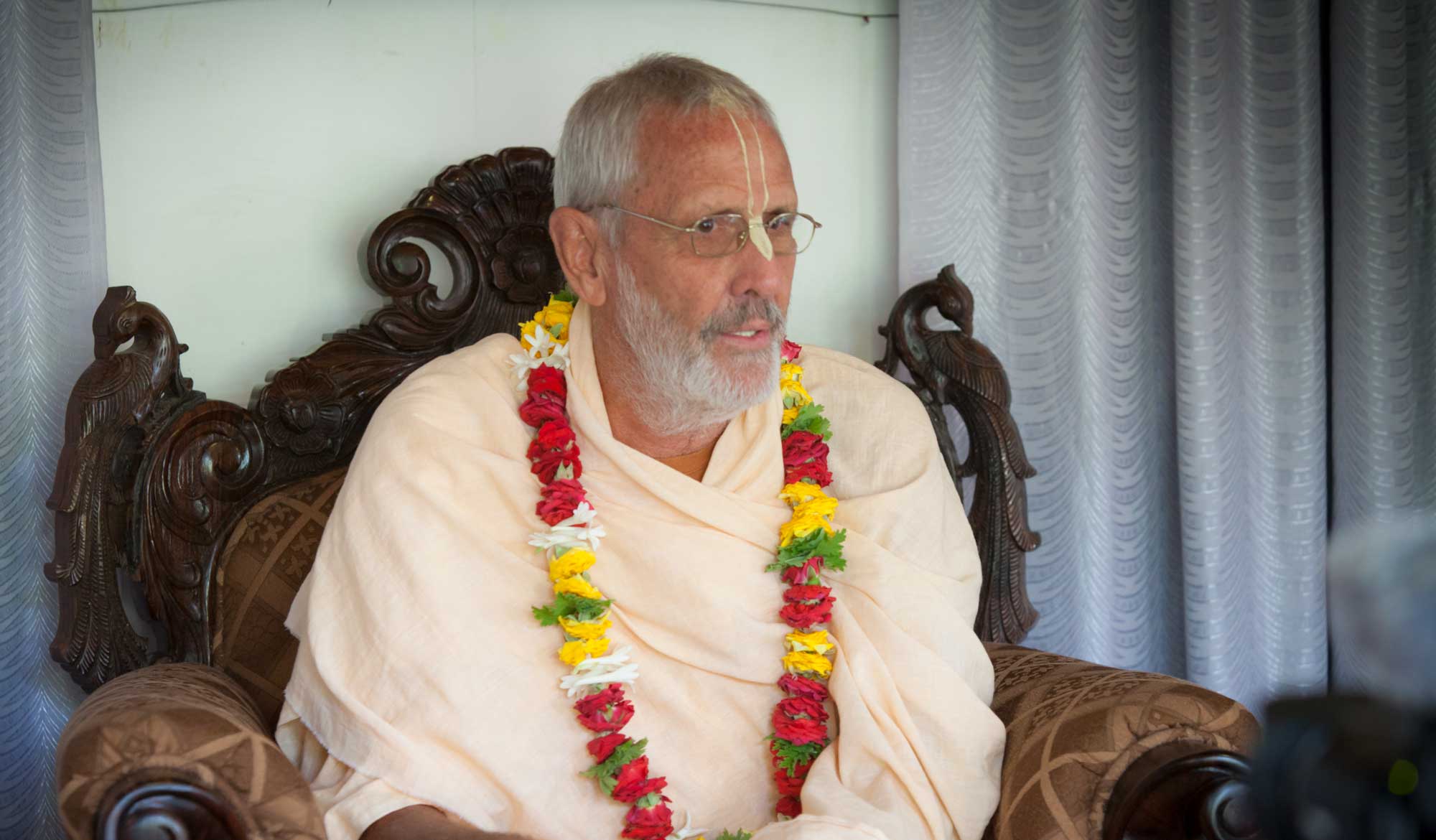Overview
The following article is adapted from a class on Caitanya-caritāmṛta, Ādi-līlā 4.68, given by Śrīla B.G. Narasiṅgha Mahārāja on Rādhāṣṭamī, September 10th 1997. Mahārāja systematically explains the process of bhakti starting with śraddhā and culminating in prema, which is personified as Śrīmatī Rādhārāṇī.
There are two types of hlādinī-śakti – that which emanates from Kṛṣṇa, and that which emanates from the living being. The feelings that we experience in this world are called bhāvas (emotions) and they are centred around various types of love – friendship, family, society, country, animals etc. These types of love are the perverted material reflections of the hlādinī-śakti. Such sentiments do not satisfy the Supreme Lord. If you follow the train of such sentiments, you find that they are selfish sentiments meant for fulfilling ourselves, and not for pleasing the true object of our affection. Love in this world is not selfless, but selfish. We give our love to something and expect that it will be reciprocated, and when it isn’t we become angry. For example, if you go and pet a cow and she is indifferent and butts you with her head, you may give her a slap because you expected her to reciprocate your affection. Our mundane love in this material world can never satisfy Kṛṣṇa. The only type of love which satisfies Him is called prema, which He Himself gives to the living entity. Prema is generated from Him as His hlādinī-śakti, and that is called Śrīmatī Rādhikā. She is the abode of love, the essence of love. She is love personified.
In order to experience that prema we must become purified of all material consciousness. Approaching the path of Kṛṣṇa consciousness starts with śraddhā, a little faith, and lastly one comes to the stage of prema, where one is benedicted with the blessing of love for Kṛṣṇa and becomes absorbed in that hlādinī-śakti.
The next stage is sādhu-saṅga. With faith we come to associate with sādhus, those whose activities and thoughts pertain to Kṛṣṇa. Then there is bhajana-kriyā. while engaging in sādhu-saṅga, we learn the process of devotional service. This is the stage where one takes initiation (dīkṣā). During bhajana-kriyā one is supposed to learn the art of pleasing and serving Kṛṣṇa. The scriptures mention sixty-four devotional arts. Think about it! How many of these have we learned since we became a devotee? We may know how to chant on our beads and recite a few ślokas, but there are many arts for serving Kṛṣṇa. In particular, they pertain to serving the Deity – cooking, offering food for the Lord’s pleasure, dressing the Deity, playing musical instruments like the mrdaṅga and singing bhajanas. All these things come under the process of bhajana-kriyā.
Then we pass to the stage of removing contamination, anartha-nivṛtti. Anartha means the pinching desires within the heart which give us all types of troubles and pain. After accepting initiation and engaging in bhajana-kriyā, the spiritual master instructs the disciple what to do and what not to do. If one disobeys those orders, one never progresses, and the desires of material existence keep on pinching. For example, one should not read various types of novels about the mundane world. These are meaningless, pointless stories for one’s own pleasure. That is both an instruction from the scriptures and also an instruction of the spiritual master. Rather, one should study proper transcendental literature such as Śrīmad Bhāgavatam, Caitanta-caritāmṛta etc. If the disciple doesn’t pay any attention to this and continues to read mundane literature, then material desires will continue to pinch. Even if a person is chanting sixteen rounds, twenty-five rounds, or even sixty-four rounds a day, but after finishing his japa, he goes and plays computer games for two or three hours, then he’ll not get to the stage of anartha-nivṛtti. The material desires which are seated in his heart will continue to pinch him. He won’t get freed from that. Rather, an offence to the Holy Name may be committed, and when an offence to the Holy Name is committed, material desires increase.
An example has been given of pouring water on a fire. Chanting rounds and other aspects of devotional service are like building a fire. When you want to make a fire, first you look for dry wood. You can’t use a bunch of wet logs from the forest. Once you have dry wood, you have to break that into small pieces for kindle and stack that into a pile. You can’t just throw a match into the air and hope that when it lands there will be a fire! No, you have to prepare everything properly then ignite the fire. But if after making the fire you pour water around it, you will simply get smoke in your face. The fire will not burn, you cannot cook anything, and you cannot maintain any heat. The example of fire is given because fire destroys impurities.
On the one hand, if we follow some of the orders of the spiritual master but disobey others, it is like pouring water on the fire. That fire will never burn sufficiently to destroy one’s anarthas. But if we do follow all the orders of the spiritual master to the best of our ability and we please him, then a certain amount of grace will automatically come to us. He may directly see what we are doing, or he may not. Many devotees do not have direct access to their spiritual master, but they are endeavouring very sincerely. Therefore the spiritual master as the Lord in the heart knows everything and grace comes to that devotee. Then even if there are difficulties, one is able to conquer them and make progress. These anarthas are called hṛd–rogam (heart disease) of hṛdaya–granthi (knots within the heart). If you have ever eaten too much peanut butter, sometimes you experience an intense pain in your chest as it slides down. Well, these anarthas are much more painful than that. But at the final stage of anartha-nivṛtti, one watches them dissolve until they finally disappear.
As the anarthas begin to dissolve, a devotee approaches the next stage which is called niṣṭhā. Niṣṭhā means fixed. When someone learns to shoot a rifle for the first time, the barrel is moving all over the place – one minute it’s aimed at the target, the next it’s pointing in the sky. Before niṣṭhā, we are struggling. It seems as though we are going nowhere and making no progress. But niṣṭhā means that you have the goal fixed exactly in front of you and there is no more wavering. This is a very nice stage of Kṛṣṇa consciousness. At that time, even though some sediment of contamination may still exist, it is not sufficient to give us difficulty. It is like sweeping a room which has not been cleaned for years and years. In the beginning it seems as though there is endless dirt, but finally you come to a stage where the room is almost liveable and from there on, it’s an easy task. It begins to look so nice that you may even think the job is over. It’s not over! One has to persevere with all the determination one had to began with. Otherwise, at that stage sometimes one may become lax in Kṛṣṇa consciousness. But if one becomes lax, then the accumulation of anarthas may start again.
After niṣṭhā we get ruci which means a taste. A mango tree may produce so many kinds of mangoes – unripe mangoes, half-ripe mangoes, rotten mangoes. Some mangoes are good for eating directly, others are good for cooking – they’re not all the same. One who knows something about mangoes knows exactly which ones are for what. Similarly, one who has ruci knows what he has a taste for. Ruci means being able to taste the fruits of love for Kṛṣṇa when they appear. That fruit appears in our mouth, it appears in our ear, it appears within our mind. At that time, everything else seems distasteful and all the things which previously attracted us are like stool. We have no attraction for that because we have a higher taste. This is actually a very dangerous stage of Kṛṣṇa consciousness because that taste is so intoxicating and addictive. The more one tastes that fruit, the more one becomes mad after it.
When that taste becomes a little bit maddening, it becomes asakti which means attachment. In this world, everyone is attached, but we are attached to the wrong thing. We are attached to the things that give us suffering and misery. Giving up that attachment is like swinging from one rope to another. Once when I was a kid, I was trying to sneak in the back way of a sports car race and ended up getting stuck on a cliff – it was two or three hundred feet straight down and I was hanging for dear life with my tennis shoes and a couple of fingers. Finally the fire department came with a big net and a rope. First, it took them about ten minutes of shouting, telling me what to do. They lowered a big rope down and I had to pluck up the courage to let go of my present position in order to get a secure position by grabbing the rope. We are holding the rope of material attachment. Attachment is always there with the living entity, but making the decision of letting go of our material attachments and grabbing the rope of Kṛṣna consciousness may create some uncertainty and doubts in our mind. If we don’t make that leap of faith, then we will remain hanging onto all these things which are actually the source of our suffering.
Therefore in the beginning we have to cultivate transcendental knowledge. If we only cultivate knowledge of this material world, which only culminates in getting a job and earning some money, then we become more entangled in the perplexities of material existence and can never see the fallacy of this world. That is not knowledge. That is avidyā – ignorance. Who is Kṛṣna? What is the soul? What is the relationship between these two? What is this material world? How is it working? This is real knowledge and if we cultivate this, we will know what to do and what not to do. We find this knowledge in the Bhagavad-gītā, Śrīmad Bhāgavatam, Caitanya-caritāmṛta and in the songs of the great ācāryas. There is so much knowledge of our relationship with Kṛṣṇa and how to make progress in Kṛṣṇa consciousness. We have to cultivate that in a practical way, then we can cultivate attachment to that which is beneficial. Asakti means developing intense attachment for Kṛṣṇa’s name, form, qualities, pastimes, paraphernalia, entourage, all those things which are related to His service. When we become very attached to them, then the awakenment of the emotions of love for Kṛṣṇa begins to manifest within our hearts.
When this asakti becomes so intense, then it becomes an emotional state. That is called bhāva. Attachment gives rise to emotions. We have seen this practically. When someone is very attached to something and there is some disturbance, an emotional state manifests. They become angry, they cry, they become unreasonable and irrational So also on the spiritual side, the attachment to Kṛṣṇa intensifies so much that emotions, or bhāva, manifests. Bhāva is like the rising sun. It is the awakening stage for prema – the full-fledged expression of feelings for love for Kṛṣṇa.
When bhāva increases and becomes fully manifested, that is known as prema. Prema has many different shades. There are various types of kṛṣṇa-prema. In Vaikuṇṭha there is vaikuṇṭha-prema and in Goloka there are śanta, dāsya, sakhya, vātsalya and mādhurya–rasa–prema. In each of these rasas, there are categories of love for Kṛṣṇa. Love is the most tasteful thing. It is the most meaningful. It is the deepest thing. It is the ultimate thing in all existence.
Even in this world, so much is made of love. Every song talks about it because that is the highest thing even in this world. Love is the ultimate thing. But time and time again, where does mundane love end? It ends in frustration, it ends in disease, it ends in disaster, and as Prabhupāda once wrote, “It sometimes ends in ghastly murder!” Lovers kill each other or they commit suicide. Why is that? Because, yes – ultimately love is the greatest thing. Without it, nothing would exist. If there was no love for God, nothing would exist. We wouldn’t even exist. It is the ultimate principle within the principle of God.
Some people have understood this point in a vague way. In the west they sometimes say, “God is Love,” but the Vaiṣṇavas say, “No, love is greater than God because He Himself is attracted by it. He becomes subservient to it.”
But love is not impersonal. Ultimately love is a person, and that person is Śrīmatī Rādhārāṇī. She has been described as the Mother of devotion. That means that devotion is born from Her. She is the personification of devotional service. Devotional service is a great science. It is not simply for morons! You have to pay proper attention to what you are doing and learn how to progress. This means following the process without over-endeavour, having the right association, and knowing what is the goal.
There is an analogy where Kṛṣṇa is likened to a dark cloud and Rādhārāṇī is compared to a bolt of lightning. In the night sky you cannot see a rain cloud, especially on a dark-moon night. But a bolt of lightning can reveal everything. Kṛṣṇa and His pastimes are very bewildering. In fact, they are mostly misunderstood by everyone who comes in contact with them. But Rādhārāṇī does not do anything to bewilder the conditioned souls. She only gives illumination. She is that principle that reveals Kṛṣṇa. By approaching Kṛṣṇa without the grace of His internal potency, one will be misled and bewildered. Without Her blessing, no one can know Him.
Related Articles
- Śrī Śrī Rādhā Kṛṣṇa & The Fountainhead of All Tattvas by Śrīla Bhakti Pramoda Purī Gosvāmī
- A Prayer Composed on the Occasion of the Disappearance of Śrīla Gadādhara Paṇḍita by Śrīla Bhakti Pramoda Purī Gosvāmī
- The Appearance of Śrīla Gadādhara Paṇḍita by Śrīla Bhakti Rakṣaka Śrīdhara Deva Gosvāmī
- Śrī Śarādīyā Pūjā by Śrīla Bhakti Rakṣaka Śrīdhara Deva Gosvāmī
- Śrī Lalitā Devī and Śrīmatī Rādhārāṇī by Śrīla Bhakti Rakṣaka Śrīdhara Deva Gosvāmī
- The Appearance of Rādhā-kuṇḍa by Śrīla Bhakti Rakṣaka Śrīdhara Deva Gosvāmī
- From Śraddhā to Prema by Śrīla Bhakti Gaurava Narasiṅgha Mahārāja
- Gāyatrī as Rādhārāṇī by Śrīla Bhakti Gaurava Narasiṅgha Mahārāja
- My Guru is Rādhārāṇī by Śrīla Bhakti Gaurava Narasiṅgha Mahārāja
- The Greatest Negative by Śrīla Bhakti Gaurava Narasiṅgha Mahārāja
- Śrī Rādhāṣṭamī by Śrīla Bhakti Gaurava Narasiṅgha Mahārāja
- Śrīla Śrīdhara Mahārāja and the Gem of All Conceptions by Śrīla Bhakti Gaurava Narasiṅgha Mahārāja
- Planets of Faith by Śrīla Bhakti Gaurava Narasiṅgha Mahārāja
- Rādhā-Pāda Darśana by Śrīla Bhakti Gaurava Narasiṅgha Mahārāja
- The Definition of Faith by Gaura Gopāla Dāsa
Further Reading
Pilgrimage with Swami Narasiṅgha – Part 7: Keśī Ghāṭa
Continuing with our pilgrimage series, this week Śrīla Narasiṅgha Mahārāja takes us to Keśī Ghāṭā where he tells us about Madhumaṅgala’s meeting with the Keśī demon, what Keśī represents, and how Śrīla Prabhupāda almost acquired Keśī Ghāṭa. Mahārāja also narrates his own experience. This article has been adapted from a number of talks and articles by Narasiṅgha Mahārāja.
Prema Dhāma Deva Stotram with the Narasiṅgha Sevaka Commentary – Verses 61-65
In verses 61 to 65 of 'Prema Dhāma Deva Stotram', Śrīla Śrīdhara Mahārāja narrates the pastime of Śrī Caitanya at Caṭaka Parvata In Purī and explains how the scriptures produced by Brahmā and Śiva are ultimately searching for the personality of Mahāprabhu who is merciful too all jīvas, no matter what their social position.
Prabhupāda Śrīla Sarasvatī Ṭhākura’s Visit to Ayodhyā
With the forthcoming observance of Śrī Rāma Navamī, we present 'Prabhupāda Śrīla Sarasvatī Ṭhākura’s Visit to Ayodhyā' written by Śrīla Bhaktisiddhānta Sarasvatī Ṭhākura Prabhupāda from The Gaudīyā magazine, Vol 3. Issue 21/ In December 1924, after visiting Benares and Prāyāga, Sarasvatī Ṭhākura visited the birth-site of Śrī Rāmācandra in Ayodhyā.
Śaraṇāgati – The Only Path to Auspiciousness
In this article, 'Śaraṇāgati - The Only Path to Auspiciousness', Dhīra Lalitā Dāsī analyses the process of śaraṇāgati (surrender) beginning with śraddhā (faith). She also discusses the role of śāstra and the Vaiṣṇava in connection with surrender.
Pilgrimage with Swami Narasiṅgha – Part 7: Keśī Ghāṭa
Continuing with our pilgrimage series, this week Śrīla Narasiṅgha Mahārāja takes us to Keśī Ghāṭā where he tells us about Madhumaṅgala’s meeting with the Keśī demon, what Keśī represents, and how Śrīla Prabhupāda almost acquired Keśī Ghāṭa. Mahārāja also narrates his own experience. This article has been adapted from a number of talks and articles by Narasiṅgha Mahārāja.
Prema Dhāma Deva Stotram with the Narasiṅgha Sevaka Commentary – Verses 61-65
In verses 61 to 65 of 'Prema Dhāma Deva Stotram', Śrīla Śrīdhara Mahārāja narrates the pastime of Śrī Caitanya at Caṭaka Parvata In Purī and explains how the scriptures produced by Brahmā and Śiva are ultimately searching for the personality of Mahāprabhu who is merciful too all jīvas, no matter what their social position.
Prabhupāda Śrīla Sarasvatī Ṭhākura’s Visit to Ayodhyā
With the forthcoming observance of Śrī Rāma Navamī, we present 'Prabhupāda Śrīla Sarasvatī Ṭhākura’s Visit to Ayodhyā' written by Śrīla Bhaktisiddhānta Sarasvatī Ṭhākura Prabhupāda from The Gaudīyā magazine, Vol 3. Issue 21/ In December 1924, after visiting Benares and Prāyāga, Sarasvatī Ṭhākura visited the birth-site of Śrī Rāmācandra in Ayodhyā.
Śaraṇāgati – The Only Path to Auspiciousness
In this article, 'Śaraṇāgati - The Only Path to Auspiciousness', Dhīra Lalitā Dāsī analyses the process of śaraṇāgati (surrender) beginning with śraddhā (faith). She also discusses the role of śāstra and the Vaiṣṇava in connection with surrender.








